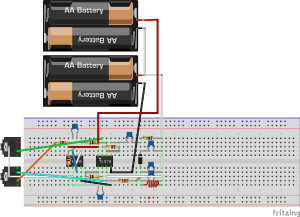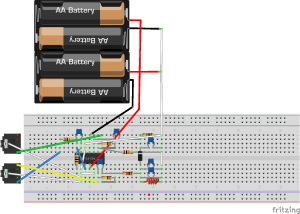IFD:Printing Acoustic Interfaces/acoustic sensing circuits: Difference between revisions
No edit summary |
No edit summary |
||
| Line 1: | Line 1: | ||
In the first part of the course we explored the possibility of a transformer based microphone, involving printed coil structures on paper. Unfortunately the printed structures have shown a large resistance, making them unsuitable for inducing magnetic field. This is because the strength of the magnetic field is proportional to the amount of current flowing through the coil, which, in turn, is limited by the resistance of the coil. It was found, that by using our printed inkjet techniques, the resistance of coils was too large by approximately two orders of magnitude. Goal: 4-20 Ohms, Actual circuits: 500-1000 Ohms. You can find the explored circuits below | In the first part of the course we explored the possibility of a transformer based microphone, involving printed coil structures on paper. Unfortunately the printed structures have shown a large resistance, making them unsuitable for inducing magnetic field. This is because the strength of the magnetic field is proportional to the amount of current flowing through the coil, which, in turn, is limited by the resistance of the coil. It was found, that by using our printed inkjet techniques, the resistance of coils was too large by approximately two orders of magnitude. Goal: 4-20 Ohms, Actual circuits: 500-1000 Ohms. You can find the explored circuits below | ||
[[/transformer microphone and 555 timer oscillator (outdated circuits)/]] | [[/transformer microphone and 555 timer oscillator (outdated circuits)/]] | ||
===Printed Capacitive (Condenser) Microphone=== | ===Printed Capacitive (Condenser) Microphone=== | ||
Revision as of 13:45, 27 June 2019
In the first part of the course we explored the possibility of a transformer based microphone, involving printed coil structures on paper. Unfortunately the printed structures have shown a large resistance, making them unsuitable for inducing magnetic field. This is because the strength of the magnetic field is proportional to the amount of current flowing through the coil, which, in turn, is limited by the resistance of the coil. It was found, that by using our printed inkjet techniques, the resistance of coils was too large by approximately two orders of magnitude. Goal: 4-20 Ohms, Actual circuits: 500-1000 Ohms. You can find the explored circuits below
transformer microphone and 555 timer oscillator (outdated circuits)
Printed Capacitive (Condenser) Microphone
However, the circuits where still working, because of another effect that was not anticipated, but stronger in the actual circuit. The capacitive effect of the two opposing coils. This capacitive effect can be made larger by providing a bigger overlapping area of the two conductors that form the microphonic surface. That simplified our print designs a little, because we were not forced to print coils as two port devices, but could use two rectangular shapes with a single port each. Leading to lesser connections and no jumper wires on our paper printed microphones.

